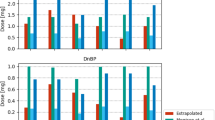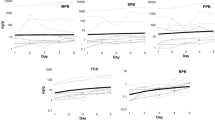Abstract
Background
Models of transdermal uptake of chemicals from clothing have been developed, but not compared with recent human subject experiments. In a well-characterized experiment, participants wore t-shirts pre-dosed with benzophenone-3 (BP-3) and BP-3 and a metabolite were monitored in urine voids.
Objective
Compare a dynamic model of transdermal uptake from clothing to results of the human subject experiment.
Methods
The model simulating dynamic transdermal uptake from clothing was coupled with direct measurements of the gas phase concentration of benzophenone-3 (BP-3) near the surface of clothing to simulate the conditions of the human subject experiment.
Results
The base-case model results were consistent with the those reported for human subjects. The results were moderately sensitive to parameters such as the diffusivity in the stratum corneum (SC), the SC thickness, and SC-air partition coefficient. The model predictions were most sensitive to the clothing fit. Tighter clothing worn during exposure period significantly increased excretion rates but tighter fit “clean” clothing during post-exposure period acts as a sink that reduces transdermal absorption by transferring BP-3 from skin surface lipids to clothing. The shape of the excretion curve was most sensitive to the diffusivity in the SC and clothing fit.
Significance
This research provides further support for clothing as an important mediator of dermal exposure to environmental chemicals.
This is a preview of subscription content, access via your institution
Access options
Subscribe to this journal
Receive 6 print issues and online access
$259.00 per year
only $43.17 per issue
Buy this article
- Purchase on Springer Link
- Instant access to full article PDF
Prices may be subject to local taxes which are calculated during checkout



Similar content being viewed by others
References
Rudel RA, Perovich LJ. Endocrine disrupting chemicals in indoor and outdoor air. Atmos Environ. 2009;43:170–81.
Weschler CJ, Nazaroff WW. Semivolatile organic compounds in indoor environments. Atmos Environ. 2008;42:9018–40.
Zaganas I, Kapetanaki S, Mastorodemos V, Kanavouras K, Colosio C, Wilks MF, et al. Linking pesticide exposure and dementia: what is the evidence? Toxicology. 2013;307:3–11.
Su PH, Chen JY, Lin CY, Chen HY, Liao PC, Ying TH, et al. Sex steroid hormone levels and reproductive development of eight-year-old children following in utero and environmental exposure to phthalates. PLoS ONE. 2014;9:1–10.
Kim YM, Kim J, Cheong HK, Jeon BH, Ahn K. Exposure to phthalates aggravates pulmonary function and airway inflammation in asthmatic children. PLoS ONE. 2018;13:1–13.
Berger K, Eskenazi B, Kogut K, Parra K, Lustig RH, Greenspan LC, et al. Association of prenatal urinary concentrations of phthalates and bisphenol a and pubertal timing in boys and girls. Environ Health Perspect. 2018;126:097004-1–097004-9.
Salthammer T, Bahadir M. Occurrence, dynamics and reactions of organic pollutants in the indoor environment. Clean - Soil, Air, Water. 2009;37:417–35.
Benning JL, Liu Z, Tiwari A, Little JC, Marr LC. Characterizing gas-particle interactions of phthalate plasticizer emitted from vinyl flooring. Environ Sci Technol. 2013;47:2696–703.
Saini A, Rauert C, Simpson MJ, Harrad S, Diamond ML. Characterizing the sorption of polybrominated diphenyl ethers (PBDEs) to cotton and polyester fabrics under controlled conditions. Sci Total Environ. 2016;563–564:99–107.
Eftekhari A, Morrison GC. A high throughput method for measuring cloth-air equilibrium distribution ratios for SVOCs present in indoor environments. Talanta. 2018;183:250–7.
Morrison GC, Andersen HV, Gunnarsen L, Varol D, Uhde E, Kolarik B. Partitioning of PCBs from air to clothing materials in a Danish apartment. Indoor Air. 2018;28:188–97.
Li HL, Ma WL, Liu LY, Zhang Z, Sverko E, Zhang ZF, et al. Phthalates in infant cotton clothing: occurrence and implications for human exposure. Sci Total Environ. 2019;683:109–15.
Morrison G, Shakila NV, Parker K. Accumulation of gas-phase methamphetamine on clothing, toy fabrics, and skin oil. Indoor Air. 2015;25:405–14.
Licina D, Morrison GC, Bekö G, Weschler CJ, Nazaroff WW. Clothing-mediated exposures to chemicals and particles. Environ Sci Technol. 2019;53:5559–75.
Blum A, Gold MD, Ames BN, Kenyon C, Jones FR, Hett EA, et al. Children absorb tris-BP flame retardant from sleepwear: urine contains the mutagenic metabolite, 2,3-dibromopropanol. Sci Am Assoc Advancement Sci. 1978;201:1020–3.
Rossbach B, Appel KE, Mross KG, Letzel S. Uptake of permethrin from impregnated clothing. Toxicol Lett. 2010;192:50–5.
Rossbach B, Niemietz A, Kegel P, Letzel S. Uptake and elimination of permethrin related to the use of permethrin treated clothing for forestry workers. Toxicol Lett. 2014;231:147–53.
Morrison G, Li H, Mishra S, Buechlein M. Airborne phthalate partitioning to cotton clothing. Atmos Environ. 2015;115:149–52.
Morrison GC, Weschler CJ, Bekö G, Koch HM, Salthammer T, Schripp T, et al. Role of clothing in both accelerating and impeding dermal absorption of airborne SVOCs. J Expo Sci Environ Epidemiol. 2016;26:113–8.
Cao J, Zhang X, Zhang Y. Predicting dermal exposure to gas-phase semivolatile organic compounds (SVOCs): a further study of SVOC mass transfer between clothing and skin surface lipids. Environ Sci Technol. 2018;52:4676–83.
Morrison GC, Weschler CJ, Bekö G. Dermal uptake of phthalates from clothing: comparison of model to human participant results. Indoor Air. 2017;27:642–9.
Cleek RL, Bunge AL. A new method for estimating dermal absorption from chemical exposure. 1. General approach. Pharm Res J Am Assoc Pharm Sci. 1993;10:497–506.
Bunge AL, Cleek RL, Vecchia BE. A new method for estimating dermal absorption from chemical exposure. 3. Compared with steady-state methods for prediction and data analysis. Pharm Res J Am Assoc Pharm Sci. 1995;12:972–82.
Wilschut A, ten Berge WF, Robinson PJ, McKone TE. Estimating skin permeation. The validation of five mathematical skin permeation models. Chemosphere. 1995;30:1275–96.
Riley WJ, McKone TE, Hubal EAC. Estimating contaminant dose for intermittent dermal contact: model development, testing, and application. Risk Anal. 2004;24:73–85.
Weschler CJ, Nazaroff WW. SVOC exposure indoors: fresh look at dermal pathways. Indoor Air. 2012;22:356–77.
Gong M, Zhang Y, Weschler CJ. Predicting dermal absorption of gas-phase chemicals: transient model development, evaluation, and application. Indoor Air. 2014;24:292–306.
Morrison GC, Weschler CJ, Bekö G. Dermal uptake directly from air under transient conditions: advances in modeling and comparisons with experimental results for human subjects. Indoor Air. 2016;26:913–24.
Morrison GC, Bekö G, Weschler CJ, Schripp T, Salthammer T, Hill J, et al. Dermal uptake of benzophenone-3 from clothing. Environ Sci Technol. 2017;51:11371–9.
Jansen R, Osterwalder U, Wang SQ, Burnett M, Lim HW. Photoprotection: Part II. sunscreen: development, efficacy, and controversies. J Am Acad Dermatol. 2013;69:867.e1–867.e14.
Kim S, Choi K. Occurrences, toxicities, and ecological risks of benzophenone-3, a common component of organic sunscreen products: a mini-review. Environ Int. 2014;70:143–57.
Janjua NR, Mogensen B, Andersson A-M, Petersen JH, Henriksen M, Skakkebaek NE, et al. Systemic absorption of the sunscreens Benzophenone-3, Octyl-Methoxycinnamate, and 3-(4-Methyl-Benzylidene) camphor after whole-body topical application and reproductive hormone levels in humans. J Invest Dermatol. 2004;123:57–61.
Janjua N, Kongshoj B, Andersson A-M, Wulf H. Sunscreens in human plasma and urine after repeated whole-body topical application. J Eur Acad Dermatol Venereol. 2008;22:456–61.
Gustavsson Gonzalez H, Farbrot A, Larko O. Percutaneous absorption of benzophenone-3, a common component of topical sunscreens. Clin Exp Dermatol. 2002;27:691–4.
Gonzalez H, Farbrot A, Larko O, Wennberg A-M. Percutaneous absorption of the sunscreen benzophenone-3 after repeated whole-body applications, with and without ultraviolet irradiation. Br J Dermatol. 2006;154:337–40.
Sarveiya V, Risk S, Benson HA. Liquid chromatographic assay for common sunscreen agents: application to in vivo assessment of skin penetration and systemic absorption in human volunteers. J Chromatogr B. 2004;803:225–31.
Krause M, Andersson AM, Skakkebaek NE, Frederiksen H. Exposure to UV filters during summer and winter in Danish kindergarten children. Environ Int. 2017;99:177–84.
Wan Y, Xue J, Kannan K. Occurrence of benzophenone-3 in indoor air from Albany, New York, USA, and its implications for inhalation exposure. Sci Total Environ. 2015;537:304–8.
Westcott JW, Simon CG, Bidleman TF. Determination of polychlorinated biphenyl vapor pressures by a semimicro gas saturation method. Environ Sci Technol. 1981;15:1375–8.
American Society for Testing & Mater. Standard test method for thermal transmittance of textile materials. American Society for Testing & Mater; 1985. p. 1–5.
Lago AF, Jimenez P, Herrero R, Dávalos JZ, Abboud JLM. Thermochemistry and gas-phase ion energetics of 2-hydroxy-4-methoxy- benzophenone (oxybenzone). J Phys Chem A. 2008;112:3201–8.
Greene RS, Downing DT, Pochi PE, Strauss JS. Anatomical variation in the amount and composition of human skin surface lipid. J Invest Dermatol. 1970;54:240–7.
Saint-Leger D, Berrebi C, Duboz C, Agache P. The lipometre: an easy tool for rapid quantitation of skin surface lipids (SSL) in man. Arch Dermatol Res. 1979;265:79–89.
Holbrook KA, Odland GF. Regional differences in the thickness (cell layers) of the human stratum corneum: an ultrastructural analysis. J Invest Dermatol. 1974;62:415–22.
Wang T, Kasting GB, Nitsche JM. A multiphase microscopic diffusion model for stratum corneum permeability. II. estimation of physicochemical parameters, and application to a large permeability database. J Pharm Sci. 2007;96:3024–51.
Nitsche JM, Wang T-F, Kasting GB. A two-phase analysis of solute partitioning into the stratum corneum. J Pharm Sci. 2006;95:649–66.
Dancik Y, Miller MA, Jaworska J, Kasting GB. Design and performance of a spreadsheet-based model for estimating bioavailability of chemicals from dermal exposure. Adv Drug Deliv Rev. 2013;65:221–36.
Eftekhari A, Frederiksen H, Andersson AM, Weschler CJ, Weschler CJ, Morrison G. Predicting transdermal uptake of phthalates and a paraben from cosmetic cream using the measured fugacity. Environ Sci Technol. 2020;54:7471–84.
Okereke CS, Kadry AM, Abdel-Rahman MS, Davis RA, Friedman MA. Metabolism of benzophenone-3 in rats. Drug Metab Dispos. 1993;21:788–91.
Okereke CS, Abdel-Rhaman MS, Friedman MA. Disposition of benzophenone-3 after dermal administration in male rats. Toxicol Lett. 1994;73:113–22.
Acknowledgements
Thanks to the Center for Research in Energy and the Environment (CREE) of the Missouri University of Science & Technology. Dr. Honglan Shi, and Gary Abbott for their help with the instruments.
Funding
Thanks to A.P. Sloan Foundation and Modeling Consortium for Chemistry of Indoor Environments for support of the modeling component of this research (MOCCIE; G-2017-9706 and G2017-12306).
Author information
Authors and Affiliations
Contributions
AE collected data, generated model simulations, drafted and revised the manuscript. JTH acquired data and helped draft the manuscript. GCM conceived of the work, supervised model simulations, revised the manuscript. All authors approved of the final version and agreed to be accountable for all aspects of the work.
Corresponding author
Ethics declarations
Conflict of interest
The authors declare that they have no conflict of interest.
Additional information
Publisher’s note Springer Nature remains neutral with regard to jurisdictional claims in published maps and institutional affiliations.
Supplementary information
Rights and permissions
About this article
Cite this article
Eftekhari, A., Hill, J.T. & Morrison, G.C. Transdermal uptake of benzophenone-3 from clothing: comparison of human participant results to model predictions. J Expo Sci Environ Epidemiol 31, 149–157 (2021). https://doi.org/10.1038/s41370-020-00280-7
Received:
Revised:
Accepted:
Published:
Issue Date:
DOI: https://doi.org/10.1038/s41370-020-00280-7
Keywords
This article is cited by
-
Exposure to oxybenzone from sunscreens: daily transdermal uptake estimation
Journal of Exposure Science & Environmental Epidemiology (2023)



